DKT Test ( Intersection) #4
When there are no arrows on the route, you must make a left turn from:
Explanation:
This allows other vehicles to pass on your right.
The traffic on the opposite side of the intersection has come to a complete stop. You're driving through an intersection and want to make a left turn. The lights are all turned on. So, what are your options?
Explanation:
Make sure you have adequate room to cross the crossing without stopping and blocking it.
On the two-lane roundabout, you want to go straight ahead. Which lane are you allowed to use?
Explanation:
You can go straight forward from either lane if the lanes are labeled that way, as long as you stay in the same lane as when you entered the roundabout.
When turning left at a roundabout, enter and exit the roundabout as follows:
Explanation:
When making a left turn, you'll start in the left lane and finish in the left lane as well.
You want to make a left. The red lights on the pedestrian lights are flashing. You ought to:
Explanation:
Pedestrians have the right of way when crossing the street.
At this roundabout, you should make a left. Which lane do you have to take, lane A or B?
Explanation:
To turn left, always utilize the left lane.
You're approaching a major intersection with slow-moving traffic and want to proceed straight. When the traffic lights become green, make sure you do the following:
Explanation:
Unnecessary dangers and delays result from blocking the intersection.
Advertisement
You're approaching a busy intersection and want to proceed straight ahead. The traffic lights change from red to green. When is it okay for you to cross the street?
Explanation:
If you park your car in the intersection, it will slow down traffic coming from other directions and put innocent people in danger.
At a railway level crossing, if the boom gates are down and the lights are blinking, you may begin crossing:
Explanation:
Even if a train has past, another train may be approaching. Wait for the boom gates to rise and the lights to cease blinking before proceeding.
Is the driver of the blue car required to yield?

Explanation:
The blue car must come to a complete stop at the Give Way sign and yield to the bike.
Is the driver of the blue car required to yield?
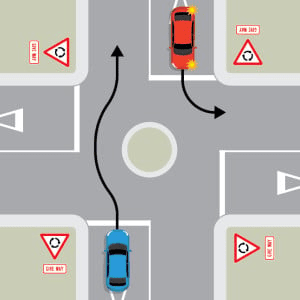
Explanation:
The blue car does not required to yield because the red vehicle will leave the circle without driving into its path.
Is the driver of the blue car required to yield?
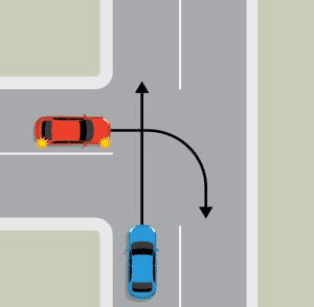
Explanation:
The blue car has the right of way since the red vehicle is turning across it from the left.
Which car must yield?
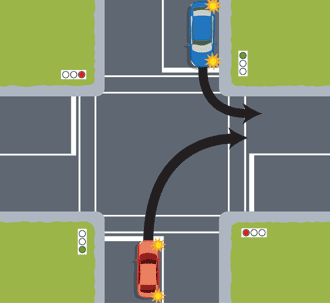
Explanation:
A vehicle turning right must yield to a vehicle turning left whenever two cars are facing each other at an intersection with the same or no traffic signs or signals (in this case, green traffic signals).
You're approaching this roundabout and want to take the arrow to the right. Is it necessary to indicate?
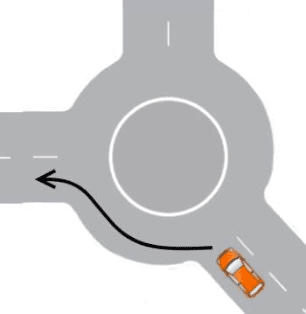
Explanation:
This is merely a left turn, and according to the roundabout's rules, you must signal left until you leave the intersection if you are approaching it and want to make a left turn.
Advertisement
Is it necessary for the driver of the blue car to yield?
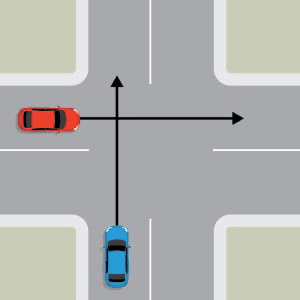
Explanation:
Give Way regulations are in effect at uncontrolled intersections. Because it is approaching from the right, the blue car in this instance has the right of way.
Is it necessary for the driver of the blue car to yield?
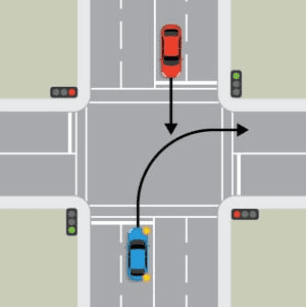
Explanation:
Even though the blue car has a green light, the Give Way regulations still apply because the red car is traveling straight through the intersection. This is because both vehicles have green lights.
Is it necessary for the driver of the blue car to yield?
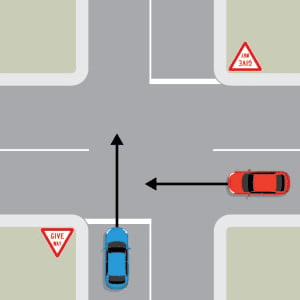
Explanation:
At the Give Way sign, the blue car must stop and yield to the red car.
Is it necessary for the driver of the blue car to yield?
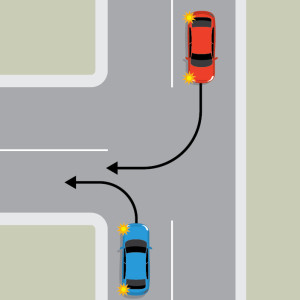
Explanation:
As the red car approaches from the other direction, the blue car is making a left turn. As a result, the blue car has the right of way, while the red car must wait.
Is it necessary for the driver of the blue car to yield?
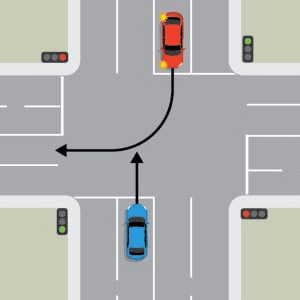
Explanation:
The turning car (the red car) must yield to the car moving straight through despite the fact that both cars have a green light (the blue car).
Is it necessary for the driver of the blue car to yield?

Explanation:
At a t-intersection, the blue car must yield the right of way to the red car because it is turning from a give way sign.